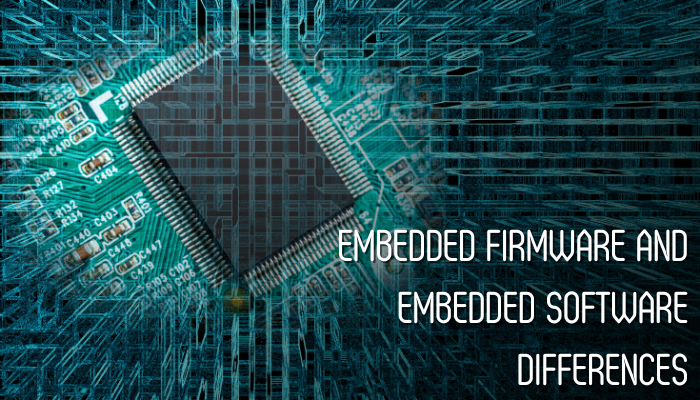In the world of embedded systems, the terms firmware and software often create confusion. While both are essential to the function of embedded devices, they serve different roles and are also developed with distinct purposes. If you’re a decision-maker in your company, it’s essential that you understand the difference between these two.
Both the embedded software and firmware are programs stored in devices. The key difference is that embedded firmware mainly controls the hardware functions, while the software works on a wider range, which is interacting with the user or operating system.
Now you might ask, why does it matter if I know the difference? For those looking to design or optimize tech-driven products, understanding these differences helps in making informed choices.
Whether you’re creating a smart device, medical equipment, or automotive system, understanding their roles enables you to create a product that performs effectively and can adapt to future innovations. Let’s understand the definitions to clarify their roles.
Defining Embedded Firmware & Embedded Software
Embedded systems are specialized computer systems that can perform dedicated functions within a larger system. Its two main components–embedded software and firmware play distinct roles to make sure the hardware operation and system performance are smooth.
Embedded Firmware: Low-Level Control and Interaction with Hardware
Embedded firmware is the brain that directly controls the hardware of a device. It interacts with the physical components like sensors, processors, or motors. The key role of firmware is to ensure that the hardware functions correctly and as expected.
- It is like a set of instructions that a device needs to run smoothly. It rarely changes once programmed into the device and updating firmware can be a complex process.
- It’s important to understand that embedded firmware is highly specific to the hardware it controls. It performs low-level tasks such as booting up the system or controlling hardware signals.
- For example, the firmware in a medical device, like a heart monitor, is programmed to collect and process data from sensors in real time. This ensures the device accurately tracks the patient’s heart rate, detects irregularities immediately, and triggers alerts or actions.
Embedded Software: Higher-Level Behavior Control within the Device
While firmware works directly with hardware, embedded software operates at a higher level. An embedded software program controls how the device behaves and interacts with the user or external systems. It runs on top of the firmware and manages tasks like user interfaces, communication protocols, and application logic.
- Embedded software is more flexible than firmware. It can be updated easily and frequently, which allows for changes in how the device functions.
- For example, the software in your smart thermostat not only takes instructions from the user but also sends data to the cloud or integrates with other devices in your home. Such high-level tasks make embedded software crucial for modern, connected devices.
- The software can be designed to work across different hardware platforms if it’s compatible with the underlying firmware. This flexibility allows for a broad range of features. Hence, embedded software is ideal for adapting to new technologies or adding advanced functionality to a product.
At Codewave, we leverage our expertise in custom software development to build reliable, scalable digital products tailored to your business needs. Our solutions are designed to align with your growth strategy, delivering high-quality outcomes through agile development practices.
So, we’ve gathered that embedded firmware serves as the operational brain of hardware devices to enable them to perform specific functions effectively. Now let’s take a look at its characteristics.
Embedded Firmware Characteristics
The characteristics include boosting the device, non-volatile memory, and security are some of the top features. Here’s a detailed look at some of them:
1. Stored in Non-Volatile Memory
Embedded firmware is typically stored in non-volatile memory like ROM (Read-Only Memory), EEPROM, or Flash. If the device is powered off, these storage types make sure the firmware is retained. Hence the firmware is highly reliable for managing the core functionality of hardware, as it doesn’t get wiped out or reset during normal operation.
Systems such as medical equipment or industrial machines must function consistently and without fail. So this stability is crucial in such devices.
2. Boosting the Device
One of its primary tasks is booting the device. When you turn on any firmware, like a smartphone or an automotive control system, it starts initially.
Without firmware, the hardware would be clueless about how to function. It prepares the hardware components and sets up communication between the device’s hardware and software. Firmware is like the operating instructions for the hardware that tells it how to start, run, and communicate with other components.
For example, firmware ensures that the sensors, motors, and processors in a smart home device work together to respond to user commands or environmental changes.
3. Security
The firmware is small and compact. Its purpose is to manage the hardware with minimal overhead, hence it’s designed to be efficient. Despite its size, firmware often includes security protocols, such as encrypted communication or authentication mechanisms, that protect the device from unauthorized access or control.
Safety and reliability are essential in industries like healthcare or automotive. Embedded firmware helps ensure that the system operates securely and protects both the user and the device from potential threats.
Whether you need secure firmware or adaptable software, Codewave offers years of experience in delivering top-notch solutions tailored to your specific needs. With our services, we help you handle these complexities efficiently to save time and ensure reliable performance.
Now, let’s check out the characteristics of embedded software.
Embedded Software Characteristics
The primary characteristics of embedded software include low resource consumption, high reliability, and real-time processing. Let’s take a look at some of the characteristics below:
1. Code Executed in the Device’s Main Memory
Unlike embedded firmware, which is stored in non-volatile memory, embedded software is loaded and executed in the device’s main memory. This means the software is more dynamic. It means the software can be updated, changed, and altered without needing to modify the hardware itself.
For systems that require regular updates or modifications to meet evolving user needs, this flexibility is very important. For example, in a smart home hub, the embedded software controls how devices communicate with each other. This offers smooth interactions between your thermostat, lights, and security cameras.
It operates within the main memory of the system. This way it can handle user interactions, data processing, and communication with external devices.
2. Controls System Behavior and Higher-Level Functions
Embedded software controls how the system reacts to external inputs, handles data, and manages communication with users or other devices.
For example, the firmware controls basic hardware functions like braking in an automotive system, while the embedded software handles the higher-level processes, such as integrating the vehicle’s infotainment system with external devices or processing data from sensors to provide feedback to the driver.
3. Dependent on CPU and Memory Capabilities
Embedded software’s performance and capabilities are directly tied to the processing power of the system’s CPU and the available memory. A more complex system with powerful hardware will be able to run more advanced software. On the other hand, a system with limited CPU and memory resources will have simpler software.
For example, a high-end security camera might use sophisticated software that processes high-resolution video, performs AI-based motion detection, and integrates with a cloud platform for remote monitoring.
4. Languages
Embedded software is typically written in high-level programming languages, with C and C++ being the most common. They’re efficient and require low-level hardware interaction.
However, modern embedded systems may also use languages like Python or Java. These are useful in cases that require ease of development or broader functionality.
For instance, C and C++ are favored in resource-constrained environments like automotive control systems or medical devices where performance and memory efficiency are critical.
Meanwhile, languages like Python and Java are often used in higher-level systems that prioritize ease of use, such as IoT devices or smart home systems.
For further understanding, let’s understand the key differences between embedded software and firmware.
Key Differences Between Embedded Firmware and Software
| Aspect | Embedded Firmware | Embedded Software |
| Specificity | Device-specific, tailored for hardware control | Broader, supports various functionalities |
| Update Frequency | Rarely updated, only when necessary | Frequently updated for improvements and new features |
| Primary Focus | Low-level hardware control and communication | Handles system behavior and user functionality |
| User Interaction | No direct user interaction | Direct interaction with users or external systems |
| Examples | Anti-lock Braking System (ABS) in cars, Pacemakers | Smart thermostat software, Car infotainment systems |
To make informed decisions when developing scalable solutions, you also need an understanding of the functional differences.
Functional Comparison: Embedded Firmware vs. Embedded Software
In the world of embedded systems, it’s important to understand how embedded software and software devices work. This comparison looks at what each one does, how they function, and how they are updated.
Embedded Firmware
The firmware acts as the translator between the hardware and the higher-level system. It communicates directly with the physical components of a device—whether that’s sensors, processors, or motors. It checks that they function as intended.
Firmware is essential because it provides the low-level control needed to start up the device and manage its core operations. For instance, the embedded firmware in a printer manages basic operations like feeding paper and initializing print commands.
Embedded Software
Embedded software encompasses the operating system (OS), middleware, and application layers that define how the device behaves and how it interacts with the user. These layers offer advanced features, customization, and broader functionality.
Embedded software often includes user-facing elements, such as the interface of a smart home system or the infotainment system in a car. It manages complex tasks like communication with external devices, real-time data processing, and connectivity.
Update Considerations
One of the critical differences between embedded software and firmware is how each layer is updated.
- Firmware updates are rare because they interact directly with the hardware. Any type of change requires careful testing to avoid disruptions. A firmware update might occur to fix a bug or add security measures.
- Embedded software is updated regularly, as it handles higher-level tasks that often need refinement or new features. As these updates don’t directly affect the underlying hardware, they can happen more easily. Software updates help maintain the system’s flexibility and respond to user feedback.
If you are still confused between embedded software and firmware, take a look at the devices that rely on embedded systems.
Examples of Embedded Firmware and Software in Devices
Let’s explore specific examples of how these technologies are utilized in real-life applications.
Home Appliances
- Smart Lights: They rely on embedded firmware to handle basic functions like turning on, dimming, and changing colors based on the hardware commands. The embedded software, on the other hand, connects the light to external systems like your smartphone or home assistant.
- Washing Machines: These use the firmware to control essential operations like the spin cycle, water levels, and temperature. Meanwhile, the embedded software manages user-friendly features like selecting specific washing programs, error notifications, and smart diagnostics.
Consumer Electronics
- Smartwatches: They are a great example of how the firmware controls functions like monitoring heart rate, while the software manages connectivity with your phone, displaying notifications, running apps, and even controlling music.
- Smart Televisions: These run complex embedded software that manages everything from streaming apps to browsing the internet, while the firmware is responsible for handling basic operations like powering the device, tuning the display, and adjusting brightness and sound levels.
Industrial Applications
- Medical Devices: Devices such as insulin pumps or pacemakers, rely heavily on the firmware to perform critical tasks like monitoring patient vitals or delivering medication at scheduled intervals. The embedded software might control data reporting, user interfaces, or cloud-based health monitoring.
- Industrial Machinery: The firmware manages mechanical operations, such as controlling motors, pressure sensors, or temperature systems. The embedded software helps in managing workflows, collecting performance data, and providing diagnostic reports that can be accessed remotely.
Automation Systems
- Smart Thermostats: They use firmware to control basic temperature regulation functions, while the embedded software allows you to set schedules, monitor energy usage, and control the system remotely through an app.
- Traffic Control Systems: These are another example where firmware manages real-time sensor data from cameras and lights, while software ensures the dynamic adjustment of traffic lights based on current traffic conditions.
- Motion Detection Systems: These systems rely on firmware for real-time hardware control, such as triggering alarms when movement is detected. Embedded software processes the data and integrates with broader security systems, sending notifications to the user or connecting with emergency services.
Now, how do embedded systems work in terms of app development?
How Embedded Firmware and Software Are Used in App Development?
In the realm of app development, embedded software, and firmware serve different roles which complement each other. Both of these work together to enhance functionality and user experience. Here’s how they are utilized:
Embedded Firmware
- Device Control: Firmware directly interacts with the hardware of devices which allows apps to control functionalities like sensors, motors, and displays.
- Real-time Processing: It ensures real-time responses to user inputs or environmental changes. This is crucial for applications like smart home devices and industrial machinery.
- Low-level Operations: Firmware manages basic operations, such as booting the device and handling power management, which are essential for the stability and performance of an app.
Embedded Software
- User Interface Development: Software provides the framework for developing user interfaces which lets users interact with the app seamlessly.
- Connectivity and Communication: It facilitates communication between devices and external networks, so apps can sync data or control multiple devices simultaneously.
- Advanced Functionality: Embedded software supports complex features like data analytics, cloud connectivity, and integration with other applications, enhancing the overall capability of the app.
Partner with a team like Codewave to ensure your software remains flexible and responsive to changes. Our Web App Development services are designed to help you build and maintain dynamic applications that adapt to your evolving business needs.
Conclusion
Understanding the difference between embedded software and firmware is essential for developing modern, tech-driven products. Both play crucial roles in how embedded systems function but in very different ways.
Embedded firmware acts as the bridge between hardware and software, ensuring that the hardware operates correctly. On the other hand, embedded software provides higher-level functionality, is more flexible, and can be updated frequently to enhance user interaction and system capabilities.
Whether you’re developing consumer electronics, industrial machinery, or automation systems, both firmware and software are necessary if you want your product to function properly and adapt to future innovations.
At Codewave, we specialize in integrating embedded firmware and software into scalable products designed to meet your business needs. Whether you need secure, hardware-specific firmware or adaptable, user-focused software, we can help you develop solutions that offer both reliability and flexibility.
Let Codewave help you unlock the full potential of your embedded systems. Reach out to us today to explore how we can help you build smarter, more innovative products.
Codewave is a UX first design thinking & digital transformation services company, designing & engineering innovative mobile apps, cloud, & edge solutions.







